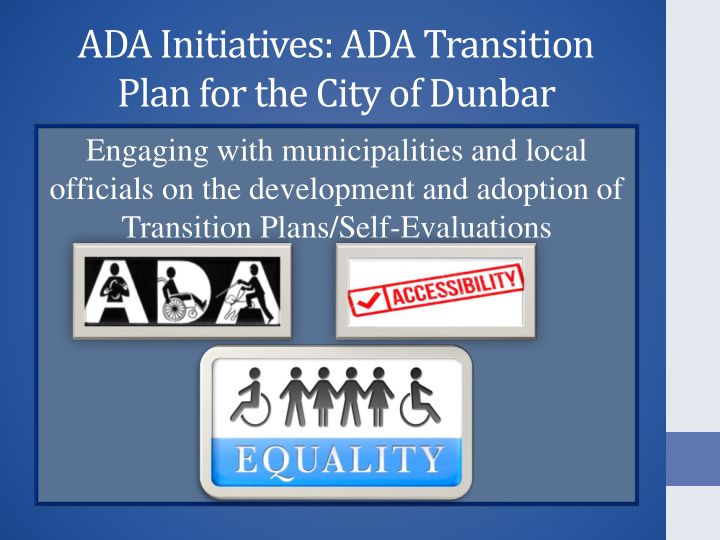



ADA Initiatives: ADA Transition Plan for the City of Dunbar Engaging with municipalities and local officials on the development and adoption of Transition Plans/Self-Evaluations
Please Note: • This presentation does not provide any legal advice • For all intended purposes, information and materials act as informal guidance
This is not… • A presentation on ADA Design or Engineering Standards Nor: • A session on compliant construction, design
Topics of Discussion • ADA Overview/Background • Basics of Transition Plans/Self-Evaluations • Promote discussion amongst MPO’s, share techniques/advice on how to engage with local officials
ADA Background • Passed by Congress in 1990, the Americans with Disabilities Act (ADA) is the nation's first comprehensive civil rights law addressing the needs of people with disabilities, prohibiting discrimination in employment, public services, public accommodations, and telecommunications.
ADA Background (Cont’d.) • Title II (State and Local Governments) • U.S. Department of Justice (USDOJ) enforces and regulates • Section 504 of the Rehabilitation Act of 1973 states that programs and facilities funded with federal money must be accessible • All programs and new/altered facilities must be accessible
Discussion • Training sessions or seminars relating to ADA? • Self-Evaluation/Transition Plan Timeline • Self- Evaluations were due in early 90’s (Required for all public agencies)
Did You Know? • 18.8%- WV’s disability population (The Nation’s Highest ) • National Average: 12%
Something to Remember… • ADA improvements benefit everyone • Non-compliance has and can lead to legal consequences • Resources on some significant court cases can be found online
Example… • Barden v. City of Sacramento • Regarding access to the city’s sidewalks, settled in 2004 • City originally agreed to settle, then tried to appeal
Barden v. Sacramento • Sued for failing to install curb ramps, or to maintain them • Also for refusal to remove obstacles from sidewalks such as benches, wires protruding from walkways, etc.- Obstacles that made sidewalks dangerous and/or impassable • Refused to develop transition plan as required by law
Barden v. Sacramento • The city attempted to argue in original lawsuit and appeal to the Supreme Court that sidewalks are not a “service” of governments as defined by the ADA • Appeal: Denied
Barden v. Sacramento • ADA regulations clearly provide "that newly constructed or altered sidewalks and intersections must include curb ramps" -- citing 28 C.F.R. 35.151(e). And while this may indeed incur costs for cities, it said, "in enacting the ADA, Congress made a determination that the societal benefits of promoting community access to those with disabilities outweigh the societal costs of complying with the ADA."
Barden v. Sacramento • Settlement called for the city to dedicate 20% of its transportation funds for 30 years for ADA improvements • Additionally, legal fees/restitution of approximately $1 million • Litigation similar in nature have been brought forth
PROWAG Background • Public Right-of-Way Accessibility Guidelines (PROWAG) (Guidelines that are used to design and construct buildings and other facilities)
PROWAG (Continued) • PROWAG has not yet been adopted, it is still in DRAFT form • Has been in draft form since the early 2000’s, several versions have since been released
ADAAG • ADA Accessibility Guidelines, (ADAAG) • Published in 1991 • Details scoping and technical requirements to be applied during the design, construction, and alteration of buildings and facilities covered by titles II and III of the ADA
PROWAG vs. ADAAG • ADAAG does not provide guidance on modifications such as sidewalks, curb ramps, etc.
The Process
Self-Evaluations
Self-Evaluations • Readily available and on file for inspection • Identifies existing deficiencies and necessary modifications • Continual Process-Why?
Self-Evaluations What is not in compliance? ✓ Focus on providing maximum accessibility to the highest feasible extent ✓ Never interested in “minimums” ✓ Includes evaluating current policies and procedures
Self-Evaluations • To have been initiated and accomplished by July 26, 1995 • One of the first documents DOJ would ask for in the event of a complaint
Online Resources for Self-Evaluations • ADA “ Checklist for Existing Facilities ” http://www.adachecklist.org/checklist.html • FHWA - “ Federal-aid Essentials for Local Public Agencies, Self- Evaluation Basics” https://www.fhwa.dot.gov/federalaidessentials/catmod.cf m?id=33 • www.adata.org – Good Resource for ADA guidance
Transition Plans
Transition Plans • Purpose: To establish necessary actions to complete modifications/alterations • Also provides a schedule for completion • Entails prioritization process for planned improvements
Transition Plans ✓ Designation of an ADA Coordinator ✓ Provide Public Notice ✓ Adopt a grievance procedure ✓ Conduct a Self-Evaluation ✓ Develop/Adopt Transition Plan
Transition Plans Prioritization Process: -Modifications must be prioritized -Criteria for this process can be found online -Include modifications that align with planned alterations such as utility work, paving, streetscaping, etc. • “Town of Calico Rock, ADA Transition Plan”
ADA Transition Plan for the City of Dunbar, West Virginia
City of Dunbar • The City of Dunbar recently completed and adopted their ADA Transition Plan (Self-Evaluation included) • Designated City’s Mayor as ADA Coordinator, common practice for smaller municipalities
City of Dunbar • Completed and scheduled alterations and modifications in conjunction with ongoing Streetscape projects • Worked with city officials throughout the process • Prompted surrounding municipalities to take action
Additional Resources • U.S. DOJ’s “ADA Guide for Small Towns” (2000) • www.ada.gov • www.access-board.gov • www.adainfo.org • www.adata.org
Questions/Comments
Recommend
More recommend